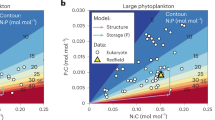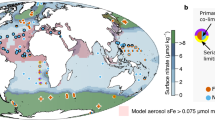Abstract
Redfield noted the similarity between the average nitrogen-to-phosphorus ratio in plankton (N:P = 16 by atoms) and in deep oceanic waters (N:P = 15; refs 1, 2). He argued that this was neither a coincidence, nor the result of the plankton adapting to the oceanic stoichiometry, but rather that phytoplankton adjust the N:P stoichiometry of the ocean to meet their requirements through nitrogen fixation, an idea supported by recent modelling studies3,4. But what determines the N:P requirements of phytoplankton? Here we use a stoichiometrically explicit model of phytoplankton physiology and resource competition to derive from first principles the optimal phytoplankton stoichiometry under diverse ecological scenarios. Competitive equilibrium favours greater allocation to P-poor resource-acquisition machinery and therefore a higher N:P ratio; exponential growth favours greater allocation to P-rich assembly machinery and therefore a lower N:P ratio. P-limited environments favour slightly less allocation to assembly than N-limited or light-limited environments. The model predicts that optimal N:P ratios will vary from 8.2 to 45.0, depending on the ecological conditions. Our results show that the canonical Redfield N:P ratio of 16 is not a universal biochemical optimum, but instead represents an average of species-specific N:P ratios.
This is a preview of subscription content, access via your institution
Access options
Subscribe to this journal
Receive 51 print issues and online access
$199.00 per year
only $3.90 per issue
Buy this article
- Purchase on Springer Link
- Instant access to full article PDF
Prices may be subject to local taxes which are calculated during checkout


Similar content being viewed by others
References
Redfield, A. C. The biological control of chemical factors in the environment. Am. Sci. 46, 205–221 (1958)
Falkowski, P. G. Rationalizing elemental ratios in unicellular algae. J. Phycol. 36, 3–6 (2000)
Tyrrell, T. The relative influences of nitrogen and phosphorus on oceanic primary production. Nature 400, 525–531 (1999)
Lenton, T. M. & Watson, A. J. Redfield revisited 1. Regulation of nitrate, phosphate, and oxygen in the ocean. Glob. Biogeochem. Cycles 14, 225–248 (2001)
Rhee, G.-Y. Effects of N:P atomic ratios and nitrate limitation on algal growth, cell composition and nitrate uptake. Limnol. Oceanogr. 23, 10–25 (1978)
Sterner, R. W. & Elser, J. J. Ecological Stoichiometry: The Biology of Elements from Molecules to the Biosphere (Princeton Univ. Press, Princeton, 2002)
Klausmeier, C. A., Litchman, E. & Levin, S. A. Phytoplankton growth and stoichiometry under multiple nutrient limitation. Limnol. Oceanogr. (in the press)
Rhee, G.-Y. & Gotham, I. J. Optimum N:P ratios and coexistence of planktonic algae. J. Phycol. 16, 486–489 (1980)
Bertilsson, S., Berglund, O., Karl, D. M. & Chisholm, S. W. Elemental composition of marine Prochlorococcus and Synechococcus: implications for the ecological stoichiometry of the sea. Limnol. Oceanogr. 48, 1721–1731 (2003)
Heldal, M., Scanlan, D. J., Norland, S., Thingstad, F. & Mann, N. H. Elemental composition of single cells of various strains of marine Prochlorococcus Synechococcus using X-ray microanalysis. Limnol. Oceanogr. 47, 1732–1743 (2003)
Elser, J. J., Dobberfuhl, D., MacKay, N. A. & Schampel, J. H. Organism size, life history, and N:P stoichiometry: towards a unified view of cellular and ecosystem processes. BioScience 46, 674–684 (1996)
Geider, R. J. & LaRoche, J. Redfield revisited: variability of C:N:P in marine microalgae and its biochemical basis. Eur. J. Phycol. 37, 1–17 (2002)
Shuter, B. J. A model of physiological adaptation in unicellular algae. J. Theor. Biol. 78, 519–552 (1979)
Kooijman, S. A. L. M. Dynamic Energy and Mass Budgets in Biological Systems 2nd edn (Cambridge Univ. Press, UK, 2000)
Tilman, D. Resource Competition and Community Structure (Princeton Univ. Press, NJ, 1982)
Letelier, R. M. & Karl, D. M. Role of Trichodesmium spp. in the productivity of the subtropical North Pacific Ocean. Mar. Ecol. Prog. Ser. 133, 263–273 (1996)
Hutchinson, G. E. The paradox of the plankton. Am. Nat. 95, 137–145 (1961)
Tilman, D. & Pacala, S. in Species Diversity in Ecological Communities (eds Ricklets, R. & Schluter, D.) 13–25 (Univ. Chicago Press, Chicago, 1993)
Droop, M. R. The nutrient status of algal cells in continuous culture. J. Mar. Biol. Assoc. UK 54, 825–855 (1974)
Litchman, E. & Klausmeier, C. A. Competition of phytoplankton under fluctuating light. Am. Nat. 157, 170–187 (2001)
Broecker, W. S. & Henderson, G. M. The sequence of events surrounding Termination II and their implications for the cause of glacial-interglacial CO2 changes. Paleoceanogr. 13, 352–364 (1998)
Pahlow, M. & Riebesell, U. Temporal trends in deep ocean Redfield ratios. Science 287, 831–833 (2001)
Copin-Montegut, C. & Copin-Montegut, G. Stoichiometry of carbon, nitrogen, and phosphorus in marine particulate matter. Deep-Sea Res. 30, 31–46 (1983)
Karl, D. M. et al. Ecological nitrogen-to-phosphorus stoichiometry at station ALOHA. Deep-Sea Res. II 48, 1529–1566 (2001)
Schneider, B., Schlitzer, R., Fischer, G. & Nöthig, E.-M. Depth-dependent elemental compositions of particulate organic matter (POM) in the ocean. Glob. Biogeochem. Cycles 17, 1032 (2003)
Quigg, A. et al. The evolutionary inheritance of elemental stoichiometry in marine phytoplankton. Nature 425, 291–294 (2003)
Behrenfeld, M. J. & Falkowski, P. G. A consumer's guide to phytoplankton primary productivity models. Limnol. Oceanogr. 42, 1479–1491 (1997)
Kirk, J. T. O. & Tilney-Bassett, R. A. E. The Plastids: Their Chemistry, Structure, Growth and Inheritance 6 (Freeman Press, London, 1967)
Raven, J. A. Nutrient transport in microalgae. Ad. Microb. Physiol. 21, 147–226 (1980)
Aksnes, D. L. & Egge, J. K. A theoretical model for nutrient uptake in phytoplankton. Mar. Ecol. Prog. Ser. 70, 65–72 (1991)
Acknowledgements
We thank P. Falkowski, I. Loladze, S. Pacala and D. Tilman for comments and discussion. We acknowledge support from the Andrew W. Mellon Foundation and the National Science Foundation.
Author information
Authors and Affiliations
Corresponding author
Ethics declarations
Competing interests
The authors declare that they have no competing financial interests.
Supplementary information
Supplementary Information
Structural N:P ratio of 29 species of freshwater and marine phytoplankton. (PDF 39 kb)
Rights and permissions
About this article
Cite this article
Klausmeier, C., Litchman, E., Daufresne, T. et al. Optimal nitrogen-to-phosphorus stoichiometry of phytoplankton. Nature 429, 171–174 (2004). https://doi.org/10.1038/nature02454
Received:
Accepted:
Issue Date:
DOI: https://doi.org/10.1038/nature02454
This article is cited by
-
Consistent stoichiometric long-term relationships between nutrients and chlorophyll-a across shallow lakes
Nature Communications (2024)
-
Changes in nutrient stoichiometry in responding to diatom growth in cyclonic eddies
Geoscience Letters (2023)
-
Carbon, Nitrogen, and Sulfur Contents in Marine Phytoplankton Cells and Biomass Conversion
Journal of Ocean University of China (2023)
-
Nutrient enrichment favors grazing selectivity and nutritional mismatch in a plankton community
Theoretical Ecology (2023)
-
Design and modelling of photobioreactor for the treatment of carpet and textile effluent using Diplosphaera mucosa VSPA
3 Biotech (2023)
Comments
By submitting a comment you agree to abide by our Terms and Community Guidelines. If you find something abusive or that does not comply with our terms or guidelines please flag it as inappropriate.



